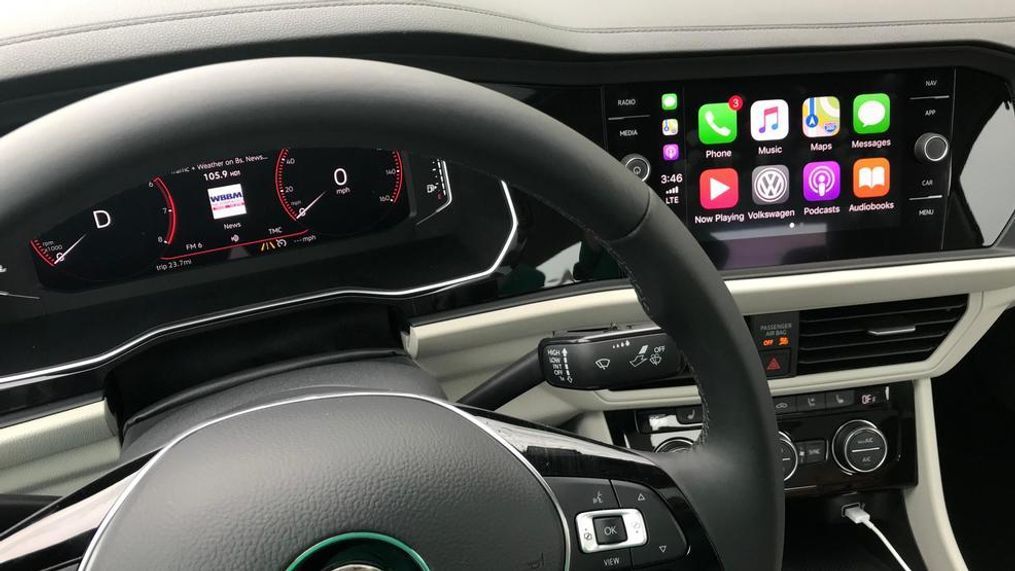7 must-have features in new cars

In 2019, automotive technology is improving at a rapid pace. And features that were once found only on luxury vehicles are starting to trickle their way down to the mainstream daily drivers.
Regardless of whether or not you’re in the market for a new car, here are seven features that are quickly becoming must haves.
Automatic high beams
The first time I experienced automatic high beams was in a Honda Ridgeline, and it was magical. I was driving on the highway at 5 a.m., and as soon as I got outside of the city, the high beams – or brights – activated. But when an oncoming vehicle approached, the Ridgeline automatically dropped down to the regular-wattage headlights. When the vehicle passed, boop, the brights were back on.
I’ve come to love this feature as my city-adapted eyes need more light on suburban or rural roads.
Heated steering wheel
The adage says: Cold hands, warm heart. But when driving, cold hands are not an asset if your grip on the steering wheel is numb. Plus, driving with gloves is a pain.
The heated steering wheel does just what it says, taking cold leather or wood-covered wheels and making them warm to the touch.
While I first encountered the heated steering wheel in a Jaguar XJ, I’ve most recently seen it in more entry-level vehicles such as the Kia Soul.
Apple CarPlay/Android Auto
Apple CarPlay and Android Auto are phone mirroring systems that work in conjunction with the vehicle’s infotainment system. The idea is to plug your phone into the USB port (or in the case of BMW, connect via Bluetooth), and then access driver-friendly apps on the vehicle’s main display screen.
This allows you to do things such as send voice-to-text messages, make phone calls, access Waze or listen to podcasts through the vehicle -- all without touching your phone.
Automatic Emergency Braking
Both the National Highway Traffic Safety Administration and the Insurance Institute for Highway Safety have made it clear that automatic emergency braking saves lives.
IIHS even includes it as a must-have feature to win a Top Safety Pick award. Luckily automakers agree, and at least 20 of them have said they’ll include it as standard fare on all vehicles by 2022.
This feature pays attention to what the driver might miss. If it senses an imminent collision, it’ll hit the brakes without driver input.
At this point, nothing is standardized, and some automakers only make this feature available at city speeds, while some make it available only at highway speeds. Plus, there’s no naming consistency, and you might see it as autonomous emergency braking, city braking, forward collision mitigation or forward collision avoidance.
If you want this feature on a vehicle – and you should – be sure to ask about it specifically during the testing process.
Adaptive Cruise Control
Most people are familiar with the concept of cruise control. Get to a specific speed on the highway, push a button, and the vehicle maintains that speed until you hit the brakes or turn it off.
Adaptive cruise control goes one step further, using radar to detect if there’s another vehicle in front of you and automatically slow down your vehicle.
Varying systems work to varying degrees, and some will decelerate to a certain speed and command you to take over, while others will decelerate all the way to a stop. Once stopped, some systems will resume forward motion automatically, and others require the driver to push a button or tap the gas pedal.
This is not an autonomous system. The driver needs to pay attention and keep hands on the steering wheel. But it does reduce driver fatigue on long highway drives and can even react to vehicles that cut you off in stop-and-go traffic.
Other names this feature goes by include dynamic radar cruise control and intelligent cruise control.
Push-Button Start
If you are used to putting a key into an ignition, it might take a bit to get used to this feature. But I’ve come to absolutely love it and depend on it.
The ignition button usually appears on the dash or center console, but in some rare occasions shows up on the steering wheel. When you enter the vehicle, all you do is put your foot on the brake and push the button to start the car.
This means the key can stay in your pocket or purse.
Passive Entry
Passive entry builds on push-button start and allows you to unlock your vehicle without pushing a button on a key fob – as long as the key fob is on your person.
The vehicle recognizes the presence of the key fob within the near vicinity as you walk up to it, and allows you to open the door with some specific action. Sometimes there’s a button on the door you push to unlock the doors; other times you simply need to grab the handle and the door will unlock.
While push-button start and passive entry are quickly becoming the norm, there is one problem with putting the key in a purse or briefcase and leaving it there – if you do need to grab the key to give to a valet, it can often be hard to find.
The Bottom Line:
A lot of these features, such as push-button start and heated steering wheels, have been around for a while. But we only saw them available on luxury vehicles – and they usually cost extra.
While they are often still options, we are finally starting to see many of these features trickle down into affordable vehicles. And in the case of automatic high-beams and emergency braking, they’re becoming standard because automakers consider them essential safety gear.
As you are shopping for your next vehicle, be sure to put as much research into available features as you do into the model you want.
